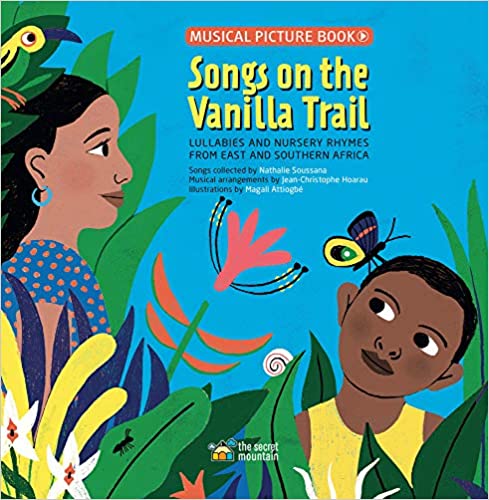Songs on the Vanilla Trail
 Songs on the Vanilla Trail : lullabies and nursery rhymes from East and Southern Africa
Songs on the Vanilla Trail : lullabies and nursery rhymes from East and Southern Africa
Picture Book / Ages 5-8
Secret Mountain
2021
80

A collection of 25 traditional songs from East and Southern Africa. The picture book is accompanied by a CD featuring 25 recorded songs along with unique code for the digital download of the audio.
This is a collection of 25 beautiful songs from Eastern and Southern Africa. It is refreshing that the islands to the East of the East African coastline are included in this skillfully compiled collection of songs. The map of East and Southern Africa highlighting the geographical position of each country covered is most helpful, as are the historical and cultural details pertaining to each community from which the songs are taken. The map and narratives help situate the origins of these songs spatially, historically and culturally. The book is also exquisitely illustrated with amazing hand drawn pictures that children will find fascinating and attractive, and that are likely to leave as profound an impression on the children as the songs themselves.
The book comes with no page numbers, which makes it hard to reference some of the specific commentary, and for users when needing to return to a specific page. Unfortunately, the author uses some terms that are no longer acceptable in public and academic discourse, particularly in reference to peoples from the global south. There is liberal use of prejudicial terms such, “slave,” “traditional instruments,” “traditional bantu languages” and, “tribal groups.” Considering that this is a children’s book, I am concerned that this will help prejudicial notions and lenses to continue to influence negatively, the way children and future generations across the globe, think about Africa and Africans. The language used can give a new lease of life to the distortions, biases and erroneous assumptions of westerners regarding Africa that rational scholars and educators are striving to redress.
The song selections themselves are excellent. They are performed by great singers and cover a wide inclusive range of East African countries, with the conspicuous exclusion of Tanzania and Zanzibar. It would have been helpful for the author to provide a background for the intended purpose of this collection and how it might be used. As a collection of lullabies, one is left to guess that it is intended for use for younger consumers of music and for educational purposes. However some questions do arise for me. Where were these music pieces recorded? Were they recorded on site in the countries represented? What is the author’s positionality in relationship to the material? It appears that the one set of musicians credited at the end of the book play on most, if not all the selections. There indeed is an acknowledgment of someone who did the musical arrangements. How did that affect the authenticity of the songs?
Most lullabies do not use the full complement of instruments that we hear on most of the recordings. Lullabies, because of their nature and function, tend to be mostly voice only. Although the musicianship on the songs is great, we are left wondering about the possible misrepresentations of the traditions presented. Indeed, one begins to detect a stylistic, timbral and sonic continuity in the songs that most likely emanates from the use of the same team of musicians to represent the music of a whole region. Other than their names and the instruments they played, no information is given as to who the musicians are and there are no details regarding their relationships to the cultures presented. For a text that makes frequent references to the issue of authenticity, I found this rather problematic.
Regarding the song, ”Mbube,” the word, “ambush” which is offered as a translation for, “isicathamiya,” is close in meaning, but is a rather misleading translation. Isicathamiya is a noun derived from the verb, ukucathama, which means to walk stealthily. The noun isicathamiya can be thought of as referring to a dance style in the way of walking stealthily. The author also suggests that, “[T]he Zulu people refer to Jesus as, ‘Lion of Judah,’ but this is not exclusive to the Zulu people as that designation is derived from the Bible (Revelations 5:5). I hope such inaccuracies are not repeated in the material regarding the regions in the book whose languages, histories and cultures I am not as familiar.
“Songs on the Vanilla Trail,” is a well-compiled set of songs from Southern and East Africa. The author should be applauded for shedding light on the less known musics and cultures of the islands off the eastern coast of Africa. The recordings themselves are very high quality, a trait that is found in the art, layout and organization of the book. The historical background provided is very helpful. However, the deficits pointed to in my review cause me to recommend that the book be used by an experienced educator who is able to circumvent its shortcomings and reinterpret the material in a more accurate and progressive manner.
Reviewed by Isaac G. Kalumbu, Jr. Ph.D.
Assistant Director – Outreach, African Studies Center, Michigan State University
Published in Africa Access Review (May 13, 2022)
Copyright 2022 Africa Access
